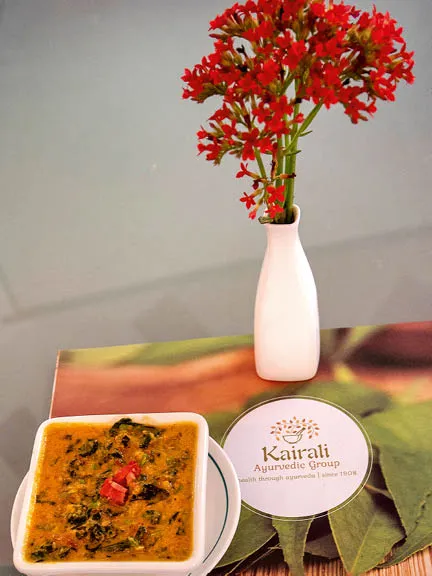

In 2020, when the pandemic hit the world, there was a sudden rise towards the Ayurvedic system of living and the Ministry of Ayush started creating awareness about the Ayurvedic food habits and use of herbs and natural sources of nutrients. The question of concern is-what exactly is the Ayurvedic system of living and what role food plays in it?
To dig a bit deeper, we recently made a visit to Kairali, The Ayurvedic Healing Village, Pallakad, Kerala which offers 30 villas amidst lush greenery and is known for its pure vegetarian, organic, and farm to table food practice. According to Dr. Deepu John of Kairali, Ayurveda is derived from two words ‘Ayu’, which means life, and ‘Veda’, which refers to science. It is the oldest medical science in the history of medicine and the aim of Ayurveda is to protect the health of a healthy person and to cure the disease of a sick person.

It was during our visit, we were informed about the value of food habits and how Ayurveda decodes food. As per Ayurveda, there are six major tastes: sweet, sour, salty, pungent, bitter, and astringent. In Ayurveda, food has been classified based on morphological features and their corresponding physiological actions. For example, grains, pulses, meat, leafy vegetables, fruits, salts, water, milk, oil, and alcoholic drinks have been elaborated based on their effect on the body.
Ayurveda believes that the kind of food one should eat also depends on the ‘Prakriti’ of the person. Prakriti is categorized as Vata, Pitta, and Kapha and the Prakriti of an individual is characterized by a set of physical, physiological, and psychological attributes.

We all know that water is life and has no colour, but at this healing village, you are served Pink Water, also known as Pathimugham. Dr. Deep John informs, “Pathimugham water is full of nutrients and is good for the human body, as it helps flush out toxins and also boost the digestive system. It is a native medicinal tree of Kerala and is also known as East Indian Rosewood. The bark of the tree is rich in nutrients and has medicinal values, which when boiled with water, turns into potent herbal water, and is full of numerous health benefits.”
Here, the food is completely sattvic and uses minimum oil and spices. From Puttu, Idli to Idiyappam and Drumstick, Beans to Pumpkin Soup, you get everything healthy and easy-to-digest. They believe that excessive cooking destroys the nutritional value of food and hence, the in-house kitchen follows the practice of ‘minimum’ cooking to keep the nutrients intact. Also, the healing village doesn’t use refrigeration, so every meal is fresh!
During our visit, we also got a chance to experience Sadya, cooked in traditional style and on the lines of Ayurveda.

For the uninitiated, Sadya is a feast of Kerala, consisting of a variety of traditional vegetarian dishes usually served on a banana leaf. A typical Sadya can have about 24–28 dishes. While relishing the meal, we were informed that Sadya is eaten without cutlery and the logic behind the practice is in sync with the philosophy of Ayurveda. It is believed that when you eat with fingers, unknowingly, you curve them to form a yogic mudra, which activates the sensory organs that keep prana in balance. It also helps in better digestion of food, as the hand touches the food, the nerves on the fingertips experience it and then send signals to the brain which instructs the body to release digestive juices. And experts believe that perhaps this is why food tastes better when eaten with hands.
A traditional Sadya includes boiled rice, served along with other dishes collectively called Kootan which include curries like parippu, sambar, rasam, pulisseri and others like kaalan, avial, thoran, olan, pachadi, kichadi, koottukari, erissery, mango pickle, naranga achaar (lime pickle), as well as papadam, plantain chips, sharkara upperi, banana, plain curd and buttermilk. The dessert served at the end of the meal is Payasam.

Before we called it a wholesome experience, we were also informed that Sadya dishes are served in specific places on the banana leaf in specific order. For instance, the pickles are served on the top left corner and the banana on the bottom left corner, which helps the server to easily identify and decide on offering additional servings.
So, are you willing to experience the authentic flavours of Ayurveda?










































Leave a Reply